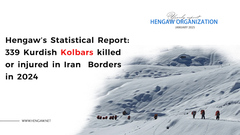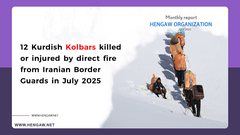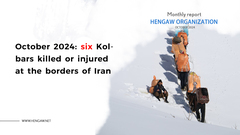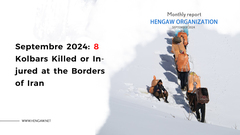Statistical Analysis of the Killing and Injuring of 334 Kolbars in Kurdistan Borders in 2023
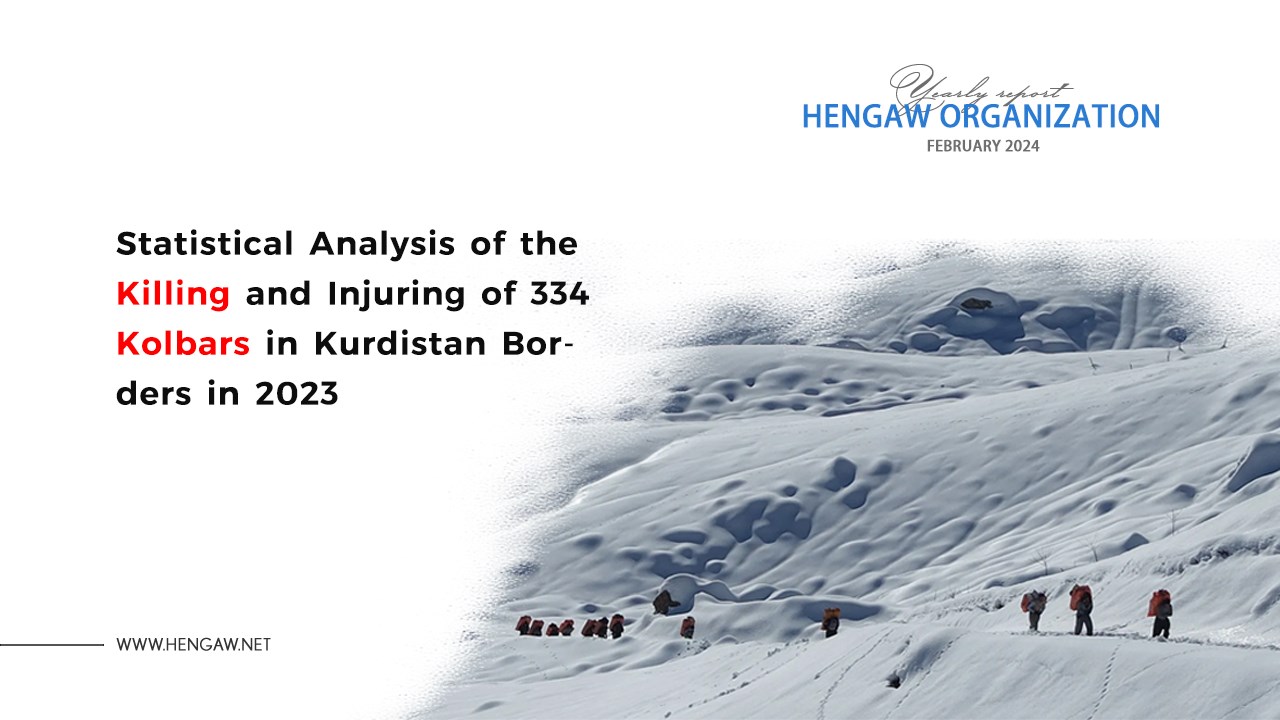
Hengaw: Thursday, February 15, 2024
According to data compiled by the Statistics and Documents Center of the Hengaw Organization for Human Rights, a total of 334 Kurdish kolbars and tradesmen were either killed or injured along the borders of Kurdistan. This figure represents a 15% increase compared to the previous year.
The report is structured into eight parts, each meticulously detailed with diagrams and statistics:
1. Preface
2. Impunity for the Perpetrators of the Kolbar Massacre
3. Comparison between 2022 and 2023 Statistics
4. Causes of Death or Injury Among Kolbars
5. Incidents Involving Teenage (Child) Kolbars in 2023
6. Geographic Distribution of Killed and Injured Kolbars by Province
7. Baneh and Nowsud Borders: Major Sites of Kolbar Fatalities in 2023
8. Conclusion
Preface:
The Kurdistan region has endured over four decades of governance under the surveillance and security framework of the Islamic Republic of Iran, resulting in profound and persistent underdevelopment and a scarcity of employment opportunities. This dire situation has given rise to Kolbari, a form of labor thrust upon individuals to meet their basic needs.
Across the Kurdistan borders (Kermanshah, Kurdistan 'Sanandaj', West Azerbaijan 'Urmia'), individuals ranging from 13 to 70 years old transport goods for businessmen either on foot or with the assistance of mules, earning meager wages. These perilous journeys span nearly impassable mountainous terrain, approximately 10 kilometers in length, between the Kurdistan Region (Iraq) and Iran, often resulting in fatalities among the porters (Kolbars).
The goods and materials transported by Kolbars include furniture, appliances, cosmetics, cloth, spare parts, factory raw materials, groceries, and more.
Unofficial estimates suggest that between 100,000 to 150,000 individuals are engaged in Kolbari. Tragically, hundreds of Kolbars perish or sustain injuries annually due to direct gunfire from Iranian, Iraqi, or Turkish armed forces, as well as natural disasters such as drowning, falls from mountains, and mine explosions, among others.
Impunity for the Perpetrators of the Kolbar Massacre
The Kolbari phenomenon, rooted in the discriminatory policies of the Islamic Republic of Iran towards Kurdistan, has escalated into a humanitarian crisis in the region. Border regiment troops, often enjoying judicial impunity, have consistently engaged in direct shootings against Kolbars, resulting in injuries and fatalities. This conduct constitutes a blatant example of extrajudicial execution and a grave violation of human rights, with full endorsement from the Iranian government and its judicial system.
Over the past seven years, despite the deaths of over 460 Kolbars and 1400 instances of severe injuries, none of the responsible authorities or perpetrators of these massacres have been held accountable in a court of law. This glaring lack of accountability illustrates the complete immunity enjoyed by these agents and underscores the unwavering support they receive from the government and judicial apparatus, perpetuating a climate of fear and terror along the Kurdistani borders.
Furthermore, wounded Kolbars and families grieving the loss of their loved ones encounter a glaring absence of state protection. Instead of receiving support, these individuals are often unjustly charged with illegal border crossing or smuggling, facing exorbitant fines as a result. Perhaps most tragically, in certain instances, families of deceased Kolbars are coerced into covering the cost of the bullets used to fatally shoot their relatives. This reprehensible practice not only re-victimizes those affected by these events but also imposes significant legal and financial burdens on these already distressed families.
Comparison between 2023 and 2022 Statistics:
Based on data compiled by the Statistics and Documents Center of the Hengaw Organization for Human Rights, in 2023, there were 41 cases of Kolbar casualties and 293 injuries along the Kurdistani borders. Notably, over 85% of these incidents involved shootings by the armed forces of the Islamic Republic of Iran. Additionally, 26 cases (8%) involved teenage (child) Kolbars.
In comparison, the statistics for 2022 indicate a total of 290 incidents, comprising 46 casualties and 244 injuries. This reflects a 15% increase in cases between the two years.
![]()
Causes of Death or Injury:
1. Direct Gunfire: Accounted for 285 cases (26 casualties and 259 injuries), constituting 85.5% of the total.
2. Mine Explosions: Occurred in 5 cases resulting in injuries, making up 1.5% of the total.
3. Intentional Murder with a Military Vehicle: Reported in 2 cases resulting in casualties, representing 0.6% of the total.
4. Driving Accidents: Involved in 13 cases (4 casualties and 9 injuries), comprising 4% of the total.
5. Frostbite: Contributed to 3 casualties, amounting to 0.9% of the total.
6. Falling from the Mountain: Occurred in 12 cases (2 casualties and 10 injuries), comprising 3.6% of the total.
7. Drowning in a River: Reported in 2 cases resulting in casualties, representing 0.6% of the total.
8. Heart Attack: Contributed to 2 casualties, amounting to 0.6% of the total.
9. Assault: Involved in 7 cases resulting in casualties, equaling 2.1% of the total.
10. Rock Throwing: Reported in 2 cases resulting in injuries, accounting for 0.6% of the total.
11. Cold Weapon Villainy: Involved in 1 case resulting in injury, making up 0.3% of the total.
Causes of Death or Injury Among Kolbars
![]()
Incidents Involving Teenage (Child) Kolbars in 2023
In 2023, the Hengaw Organization's statistics reveal that 26 teenage (child) Kolbars were either injured or killed along the Kurdistan borders, constituting 8% of the total incidents.
Among these, two teenage (child) Kolbars were killed, while 24 others sustained injuries. Of these cases, 23 (85.5%) were directly targeted by the armed forces of the Islamic Republic of Iran. One case resulted from a mine explosion, one from frostbite, and one from falling from the mountains.
The majority of casualties and injuries among teenage (child) Kolbars occurred at the Baneh border, totaling 15 cases, with an additional 8 cases recorded at the Nowsud border. Additionally, one casualty or injury was reported at each of the Marivan, Nodesheh, and Saqqez borders.
Assortment of Killed or Injured Cases Based on Province:
The statistics indicate a total of 181 cases (51% of casualties and injuries) in the Kurdistan province in 2023, representing the highest number among the other provinces.
- Kurdistan Province (Sanandaj): Recorded 181 cases, including 28 casualties and 153 injuries, amounting to 54% of the total incidents.
- Kermanshah Province (Krmashan): Reported 137 cases, comprising 7 casualties and 130 injuries, equivalent to 41% of the total.
- West Azerbaijan Province (Urmia): Documented 16 cases, with 6 casualties and 10 injuries, accounting for 5% of the total.
![]()
Baneh and Nowsud Borders: Major Sites of Kolbar Fatalities in 2023
In 2023, the borders of Baneh (Kurdistan province) and Nowsud (Kermanshah province) became synonymous with tragedy for Kolbars, witnessing a harrowing total of at least 278 cases of casualties or injuries. Remarkably, these figures constitute over 83% of the total casualties or injuries among Kolbars at any border.
Specifically, at the Baneh border, 22 Kolbars tragically lost their lives, while 116 suffered injuries. Similarly, at the Nowsud border, 2 Kolbars lost their lives, and 136 were injured.
Investigations conducted by Hengaw indicate that individuals in positions of authority bear significant responsibility for these massacres. In Kurdistan province, Mehdi Vahedi (commander of the Border Guard Command at the Baneh border) and Mostafa Moradi (deputy commander of the Border Guard Command at the Baneh border) are implicated. In Kermanshah province, Nowzar Moradi (commander of the Paveh Border Guard Command) and Major Fereydoun Rastegar (commander of the border guard company at the Nowsud border) are likewise implicated, with allegations of personal involvement in the killings of Kolbars.
Given the alarming escalation of massacres targeting Kolbars along the Kurdistani borders through direct gunfire by border regiment troops, Hengaw urgently calls for an immediate military and financial embargo of the Border Guard Command of the Islamic Republic of Iran. Furthermore, Hengaw advocates for international pursuit and prosecution of the chief commanders of this force on charges of crimes against humanity, specifically concerning their actions against Kolbars.

Conclusion
The provided report by the Hengaw Organization for Human Rights for 2023 discloses the exigent and dangerous situation of kolbars in the Kurdistan borders. Their situation does not only imply the vast economic and social obstacles that force these individuals to pursue such a perilous profession, but it is also a vivid representation of serious human rights violations and the lack of necessary legal support and security measures. The increasing number of fatalities and injuries among kolbars (particularly teenage kolbars) indicates the deficiency of the present policies and the urgent need for reconsideration and drastic measures. This report emphasizes the necessity of international attention to this problematic issue, a comprehensive approach to solving the humanitarian dilemma, and providing safe and fair living conditions for the inhabitants of these borders.
The growth of violence and life risks against Kolbars on the Kurdistani borders shows the improper economic and social conditions and the explicit violation of human rights, especially those included in Article 3 of the "Universal Declaration of Human Rights." The impunity for the responsible agents of these massacres and the absence of legal support for the victims and their families is an explicit violation of the principles of accountability and responsibility for human rights. The current situation is contradictory to the principle of responsibility of governments in support of and respect for human rights, which has been affirmed in human rights and international covenants.
Based on the data provided in this report shows that urgent economic and social actions are required to improve the livelihood of kolbars. Moreover, it is essential to scrutinize the responsibility of the government and related institutions in order to protect the natural rights of these individuals and improve human rights standards.
